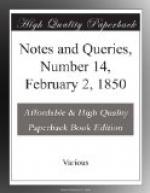G.
Draytone and Yong.—The following note was found by me among the Exchequer Records, on their sale and dispersion, a few years ago:—
“I praye you fellowe Draytone do so invehe for me as to Resave all svche moneye as is dewe to me from the handes of Ser Vincente Skyner Knyghte or else wheare from thos offysers of the excheqer And this shalbe yovr discharge. Written the laste daye of Janvarye 1607. Henry Yong.”
Can your subscribers inform me who the writer was? Mr. Payne Collier states that there was an interlude-maker of the name of Henry Yong in the reign of Henry VIII. Is it likely that the note was addressed to Michael Drayton?
ROBT. COLE.
Upper Norton Street, Jan. 23, 1850.
The Fraternity of Christian Doctrine.—I think I see some names among your correspondents who might inform me where I shall find the fullest account of the Fraternity of Christian Doctrine, established by St. Charles Borromeo in the diocese of Milan. I am acquainted with the regulations for their establishment in Acta. Concil. Mediol., and with the incidental notices of them which {214} occur in Borromeo’s writings, as also in the later authors, Bishop Burnet, Alban Butler, and Bishop Wilson (of Calcutta). The numbers of the Sunday schools under the management of the Confraternity, the number of teachers, of scholars, the books employed, the occasional rank in life of the teachers, their method of teaching, and whether any manuals have ever been compiled for their guidance—are points upon which I would gladly gather any information.
C.F.S.
Treatise by Englebert, Archbishop of Treves.—Bishop Cosin (in his Hist. Trans. cap. vii. Sec.12) refers to Engelb. Archiep. Trevirensis, ap. Goldasti Imper. tom. i. In Goldast’s Politica Imperialia there is a treatise by S. Engelb. Abb. Admoutens in Austria: but I find neither the author referred to, nor the treatise intended, by Cosin. According to Eisengrein, who is followed by Possivinus, there were two Engelberts; viz. Engelbertus, S. Matthiae Treverensis, Benedictinae possessionis Abbus, patria Mosellanus, who lived A.D. 987; and S. Engelbert, who flourished A.D. 1157, and who is described as Admontensis Benedictinae posessionis Abbus, Germanus. Can any of your correspondents kindly direct me to the intended treatise of the Archbishop of Treves?
J. SANSOM.
Oxford, Jan. 9. 1850.
New Year’s Day Custom.—I shall be glad if any of your readers can inform me of the origin and signification, of the custom of carrying about decorated apples on New Year’s Day, and presenting them to the friends of the bearers. The apples have three skewers of wood stuck into them so as to form a tripod foundation, and their sides are ornamented with oat grains, while various evergreens and berries adorn the top. A raisin is occasionally fastened on each oat grain, but this is, I believe, and innovation.




